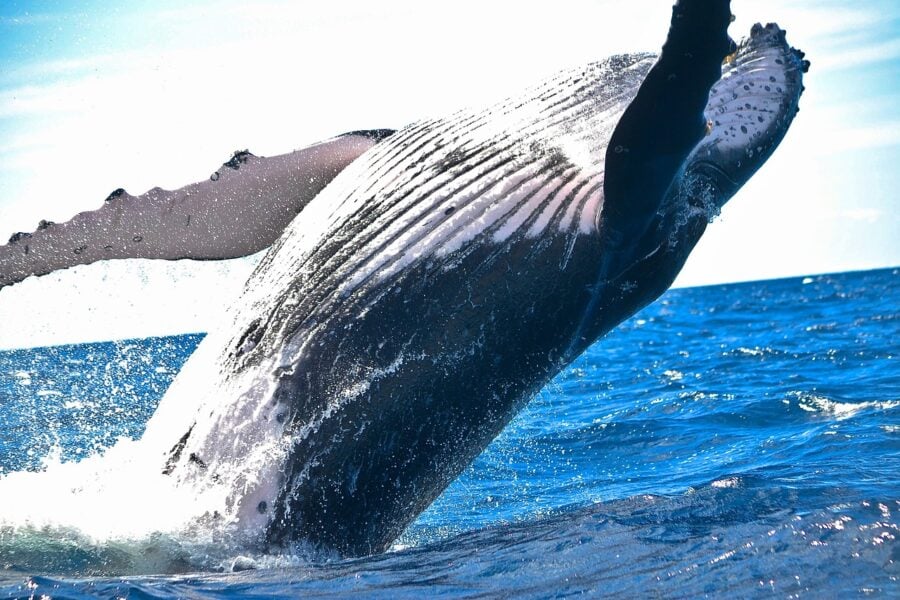Vulnerable newborn humpback whales are entering the world much farther south than scientists previously thought, navigating busy shipping lanes and urban coastlines during their most fragile life stage. This surprising discovery challenges long-held beliefs about whale migration patterns and raises urgent questions about protecting these ocean giants during their earliest days.
The UNSW-led study, published yesterday in Frontiers in Marine Science, documented over 200 sightings of newborn humpback calves in temperate waters stretching from Tasmania to New Zealand’s South Island – a staggering 1,500 kilometers south of areas traditionally recognized as calving grounds.
Birth on the Highway
For decades, scientists believed humpback whales made their epic migrations to tropical waters specifically to give birth in warm, protected areas. This new research reveals they’re far more adaptable, with mothers giving birth along what researchers call the “humpback highway” – the migratory routes connecting Antarctic feeding grounds to tropical breeding areas.
“Hundreds of humpback calves were born well outside the established breeding grounds,” said Dr. Tracey Rogers of the University of New South Wales, senior author of the study. “Giving birth along the ‘humpback highway’ means these vulnerable calves, who are not yet strong swimmers, are required to swim long distances much earlier in life than if they were born in the breeding grounds.”
What’s particularly striking is that after giving birth, most mother-calf pairs continue migrating northward rather than staying put. This challenges fundamental assumptions about what drives whale migration patterns.
A Surprising Discovery
The research began with a chance encounter. “In July 2023, during a whale-watching tour, I encountered a mum and calf at the mouth of Newcastle Harbor — the busiest shipping port in Eastern Australia,” said Jane McPhee-Frew, PhD candidate at the University of New South Wales and the study’s lead author. “The calf was tiny, obviously brand new. What were they doing there? But none of my tourism colleagues seemed surprised.”
That observation sparked a collaborative investigation combining data from citizen scientists, government surveys, and reported strandings. The researchers documented 209 newborn calves, including direct observations of 11 births.
The southernmost calf was spotted near Port Arthur, Tasmania – approximately 43 degrees south latitude – making it the highest-latitude humpback whale birth ever documented globally.
Why This Matters
The discovery has significant implications for whale conservation. Newborns face numerous threats in busier, more developed coastal waters, including:
- Vessel strikes in busy shipping lanes
- Entanglement in fishing gear and shark nets
- Noise pollution from boats and coastal development
- Chemical pollutants concentrated near urban areas
- Disruption from recreational watercraft
Instead of spending their vulnerable first days in protected tropical waters, these calves must immediately begin an arduous journey through some of Australia’s busiest waterways.
“Perhaps there are things happening in our ocean that we are yet to find out,” noted co-author Dr. Vanessa Pirotta of Macquarie University, highlighting how much remains unknown about these remarkable marine mammals.
Not A New Behavior
While these findings might seem like a recent development, evidence suggests temperate-water births may have always occurred but were simply unnoticed when whale populations were severely depleted by commercial whaling.
“I think it’s very likely that this pattern has always existed, but the low number of whales obscured it from view,” said McPhee-Frew. “The Eastern Australia humpback population narrowly escaped extinction, but now there are 30, 40, or 50,000 in this population alone. It doesn’t happen overnight, but the recovery of humpback whales, and the return of their full range of behaviors and distribution, just goes to show that with good policies built on good science we can have excellent outcomes.”
Historical records, including 19th-century whaling logbooks, contain references to mothers with young calves at similar latitudes, supporting the theory that this behavior isn’t new.
Rethinking Whale Migration
The discovery raises a fascinating question: Why do humpback whales migrate to warm tropical waters if they can give birth further south? And why, after giving birth during migration, do mothers continue swimming thousands of kilometers north with a vulnerable newborn in tow?
This study can’t answer these questions definitively, but it suggests whale migration may be more complex than previously understood. Rather than distinct “feeding grounds” and “breeding grounds” connected by migration routes, humpbacks appear to use a continuum of habitats and behaviors throughout their range.
A Community Effort
The research represents a remarkable collaboration between scientists, whale-watching operators, government wildlife agencies, and citizen scientists. Most observations came from commercial whale-watching tours and coastal photographers, highlighting the value of community engagement in marine research.
“This study was based on opportunistic observations,” cautioned McPhee-Frew. “This data is excellent for answering questions like, ‘are there newborn whales here?’ But we can’t stretch the interpretations too far. It might appear that we see more calves the further north we go, or that we have seen more over time. But it could be that there are more people whale-watching in the north, or more cameras and social media sharing in recent years.”
The findings underscore the need for expanded awareness about the presence of vulnerable newborn whales in areas where they weren’t previously expected. While legal protections already exist for mother-calf pairs across Australian waters—including maintaining distances of at least 300 meters—many recreational boaters may be unaware of these regulations or the presence of newborns.
As humpback populations continue their remarkable recovery from near-extinction, this research reveals there’s still much to learn about one of the ocean’s most iconic species. The next challenge is ensuring these newborns survive their first journey through increasingly busy coastal waters.
Discover more from Wild Science
Subscribe to get the latest posts sent to your email.

